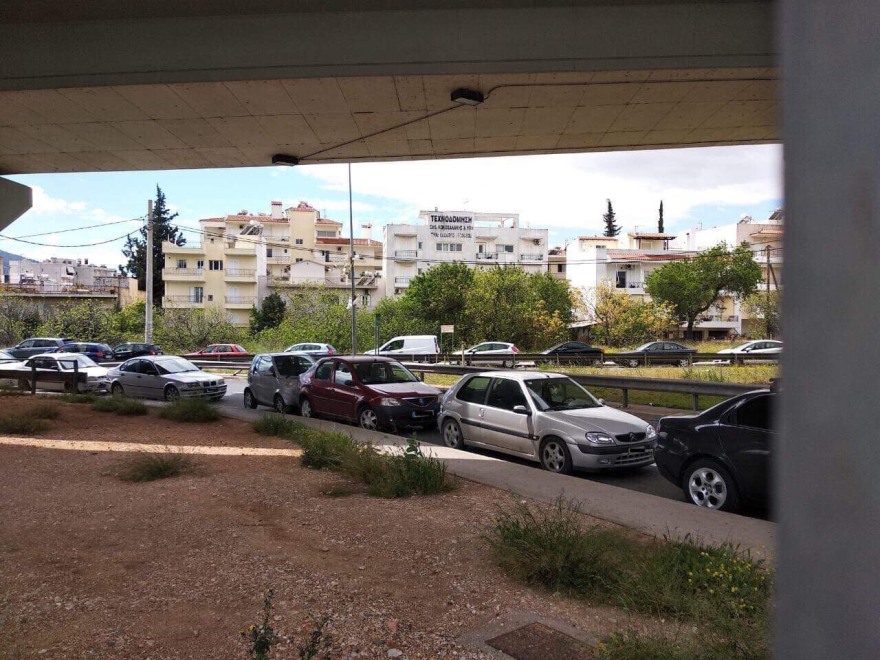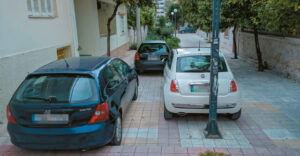If there were a government program that could have the same success as the My Home program, it would be My Parking Lot. There is such a big problem of lack of parking spaces, especially in the more saturated municipalities of Attica where a space can cost as much as an apartment.
The sale prices are unaffordable, but even when it comes to renting, Athenians sigh – sometimes one must have means to secure a parking space or even agree to pay to have their car parked on the street.
In areas of the capital city with the biggest traffic problem and the most incomplete infrastructure for on-street and permanent parking, the picture has turned to chaos. The problem is not new, but it is getting worse. In overcrowded areas, prices are soaring not just keeping pace with housing, but often approaching and even surpassing it.
Kolonaki or Monaco?
So can the rent for a parking space cost more than that for a house? Can an underground parking lot sell for more than an apartment? Is it possible in some areas to rent (illegally, of course) permanent parking spaces on the… street?
In the centre and Kolonaki, for example, monthly parking can be more expensive than Buckingham Palace (!), or, to be more specific, a space (measuring 11 sq m) in an underground, gated parking lot in Vasilissis Sofias costs 700 euros a month, more expensive than a similar supercar space in Monaco.
In Kifissia, a 14 sq m parking space costs 1,000 euros, which is more expensive than a similar space rented by Sotheby’s in a luxury residential complex in Monaco’s marina, above the famous tunnel of the principality, while a space in Gyzi’s is rented for a similar price.

In Maroussi, up Kifissias Avenue, we found a parking space in pilotage rented for 400 euros per month, in Agia Paraskevi a closed parking lot of 22 sq.m. is rented for 390 euros per month, while returning to the centre, in the not so cosmopolitan Petralona, a spacious 30 sq.m. space is rented for 280 euros, quite a bit cheaper than an underground parking space in Mavili Square, which costs 350 euros.
“Reasonable”, if you consider that a 12 sqm space in a pilotage in Maville Square costs 200 euros per month. In Exarchia for a 12 sq.m. space in a closed parking lot one would have to pay 250 euros per month, the same amount as an 11 sq.m. space in Rigillis.
In the south, in Glyfada, one can rent an open ground floor space near Grigoriu Lambraki for 320 euros per month, while in Byron, for 250 euros one can permanently park his four-wheeled pride in an underground parking lot of 13 square meters, the same price as a closed space in Pagrati and Gazi.
The situation is just as tragic in Thessaloniki. In the centre, monthly parking space rentals start at 140 euros (e.g. for Velideio), while in areas like Chanthi and Vas. Heraklion it goes up to 230 euros.
More expensive is the monthly parking in Proxenou Koromila, where prices go up to 280 euros for a space in an underground parking lot! In Thessaloniki, a new phenomenon is to convert old shops (bought for 15,000-20,000 euros) into parking lots and rent them by the month.
Precisely because of the saturation of parking spaces and the rally in real estate prices, many see the sale of a parking lot as a… business opportunity. This explains the record-breaking sale based on the contracts posted in the 2024 Real Estate Transfer Values Register: an 18 sq.m. parking space in Kifisia was sold for 487,361 euros, more expensive than a newly built three-bedroom apartment in most areas of the capital.
“That’s an exorbitant amount,” one might say, countering that in most areas of Athens, the purchase of a parking space is around 20,000 euros. A browse, however, in real estate agencies or on the classifieds pages is enough to see that there are other cases where garages are sold at prices similar or higher than those of apartments of more than a dozen times the area.
The most expensive location
The most expensive parking space available for sale, right now in the country is (where else?) in Kolonaki. It is a space in an underground parking lot which is for sale for 385,000 euros.
In the same area, one can pay 350,000 euros to buy a 60 sq.m. garage or pay “just” 200,000 euros for a closed parking space of 12 sq.m. That is, an underground parking space in the center of Athens is priced at 16,677 euros/sq.m.
A 42 sqm garage in Pasalimani is sold for 120,000 euros, while an open parking lot of 12 sqm in Lycabettus is sold for 110,000 euros (9,167 euros/sqm). For 100,000 euros one can buy a 24 sq.m. garage in Pagrati and Byron or 31 sq.m. in Ano Patissia, while at this price one can also find one in Ilioupoli, but also in the northern suburbs, in Melissia and Maroussi.
In the south stands out the garage of 60 sq.m. in Paleo Faliro (at the Planetarium) which is for sale for 165,000 euros, while at a much more reasonable price, at 35,000 euros we find a parking lot of 13 sq.m. in Alimos. In Glyfada, each square meter in an underground parking lot is priced at 4,167 euros, since a 12 square meter space is available for 50,000 euros.
In Thessaloniki, things are not much better. A 10 sq.m. pilot parking lot in Kalamaria is sold for 35,000 euros (3,500 euros/sq.m.), while in Ladadika they don’t sell exactly what you want, as the popular song goes: a 14 sq.m. space in the area is sold for 42,500 euros, i.e. 3,035 euros/sq.m., while in Voulgari a 10 sq.m. space is sold for 35,000 euros (3,500 euros/sq.m.).
And if one wants to look at it from a business point of view, one can spend 7 million euros to buy a 6,500 sq.m. parking space in Kolonaki.
Can these prices be representative, whether for rent or sale? The truth is that there are… reasonable ones in all areas, but that’s not the whole truth. In some areas with heavy traffic and zero infrastructure, there are simply no parking spaces available!
What this means in practice is that those looking for a parking space to rent will have to find… a known person who will squeeze them into one of the few remaining ones, get on a waiting list, or be forced to break the law.
In the centre of Athens, for example, there is a parking business that charges “acquaintances” 40 euros a month to park their car on the… street. It uses vehicles with which it occupies public parking spaces and moves them when the customer arrives. In Kallithea, it takes a means to find a permanent parking space, while in Nea Smyrna there is a waiting list of residents asking for a paid parking space.
In essence, a car owner, whether a resident or a visitor for work, has two choices: either pay handsomely for a permanent parking space or pay more handsomely to park on the street.
In the second case, especially if it is in areas with heavy traffic, he will be forced to make endless circles looking for a parking space that will be vacated by someone leaving, a process that can take up to hours (an incident has been recorded in Kypseli with a desperate resident who slept in his double-parked car to… catch up with his work the next day).
Otherwise, he will be forced to break the law by double parking or parking at a point where it is not allowed, risking getting a ticket or not finding his car.
What the studies show
The description of the above situation is only part of the multifactorial problem of the lack of parking spaces that now affects almost all of Greece and explains the fact that real estate market players expect that there is room for growth in this market.
A study 25 years ago reported that in the small ring road of Athens, during the night hours, about 60,000 cars were parked, while during the three-hour rush hour (10.00-13.00) another 100,000, of which more than 35,000 vehicles were surplus and parked illegally, as the supply of spaces amounted to 35,000 on-street and 25,000 off-street spaces.
According to current figures provided to THEMA by the president of the Association of Greek Traffic Engineers, Thanasis Tsianos, more than 500,000 cars enter the Little Ring Road every day, of which only 30% is for through traffic. This means that about 350,000 cars park on the small ring road alone. How many are “left over”?
The problem is, of course, not only in Athens. In Thessaloniki, the director of the University of Thessaloniki’s Transportation Engineering Laboratory Yannis Politis has reported that during the day the city centre needs 95,000 parking spaces, with the available off-street spaces amounting to 5,500, of which 65%-70% are reserved.
1,700 spaces remain free for visitors and a further 3,600 in around 40 car parks. “That means these legal spaces will have to change cars 18 times a day!
If we want to solve the traffic problem we need to multiply the parking spaces and go from 5,500 to 21,000. To have these additional 16,000 spaces we will have to create 16-17 multi-story parking lots,” the professor has explained.
Measurable data on the parking problem has also been provided by the study of the new Local Urban Plan in Heraklion, Crete. According to the study published a few days ago, 45,696 parking spaces are missing in the entire area of the Municipality of Heraklion, of which 38,058 are in the “heavy” urban fabric.
The problem concerns the whole country, whose parking infrastructure has not changed much since 1985, the year in which the number of cars on Greek roads increased by 450%, exceeding 9 million vehicles (compared to 2,036,625 then).
Of these vehicles, only 1 million are buses and trucks, 6 million are private cars and 2 million are motorcycles. 4.5 million of them are in Athens, slightly less than 1 million in Thessaloniki, 160,000 in Heraklion, 120,000 in Patras, and 110,000 in Larissa.
Lack of infrastructure
Overcrowding comes not only from on-street parking but also from a lack of infrastructure for residents. Across the country, 55% of apartment buildings were built before 1980, when building parking spaces per apartment was not even a concept, as it was a given that one would find a place to park. Today, there are about four cars in each of these apartments with no parking spaces (or one car per resident in the country), which explains the overcrowding.
Ask me anything
Explore related questions





